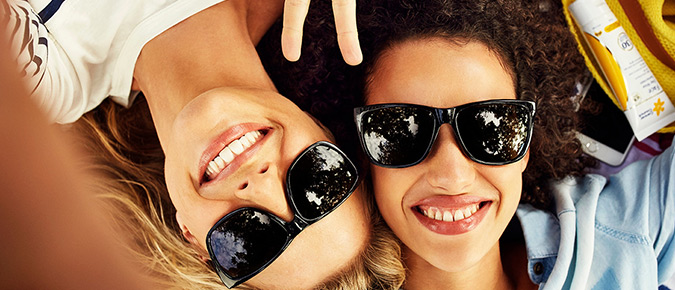- Home
- Cancer Prevention
- Sun protection
- Preventing skin cancer
- Protecting your eyes from the sun
Protecting your eyes from the sun

We recommend wearing close-fitting wraparound sunglasses and a sun smart hat to provide the best protection for your eyes from UV radiation.
UV radiation can cause short-term eye problems; for example, excessive blinking, swelling and difficulty looking at strong light. Over time, exposure to UV can cause serious or permanent eye damage:
- Cataracts (cloudiness of the lens), which may require surgery.
- Solar keratopathy (cloudiness of the cornea).
- Cancer of the conjunctiva (the membrane covering the white part of the eye).
- Skin cancer of the eyelids and around the eyes.
- Pterygium (pronounced tur-rig-i-um), which is an overgrowth of the conjunctiva onto the cornea.
Choosing sunglasses
Sunglasses don’t have to be expensive to be effective, but some cheaper fashion sunglasses don’t provide sun protection. Considerations when choosing sunglasses for best protection:
- Choose sunglasses that meet the Australian Standard AS/NZS 1067.1:2016 with a lens category of 2, 3 or 4 on the swing tag. These sunglasses absorb 95% of UV radiation.
- Be aware that category 0 and 1 are fashion spectacles, not sunglasses and do not offer good UV protection.
- Some sunglasses are marked with an Eye Protection Factor (EPF). An EPF of 9 or 10 provides excellent protection, blocking almost all UV radiation.
- Wrap around, close fitting and large lenses help to reduce reflected UV radiation and glare that can pass around the edge of sunglasses.
Sunglasses for children
The earlier young eyes are protected against UV radiation the better. If you buy sunglasses for your baby or child, make sure they meet the Australian Standard AS/NZS 1067.1:2016 and fit closely to the face. Avoid toy sunglasses, which are great for dress-ups but of little use for sun protection.
Prescription sunglasses
The Australian Standard doesn’t cover tinted or clear prescription glasses and it’s best to talk to your optometrist about your options. Some tinted or clear prescription lenses protect against UV radiation, or lenses can be coated with a UV-protective layer. Lenses that darken when exposed to sunlight reduce glare but may not filter out UV radiation.
Eye protection at work
Workers can also be exposed to other sources of radiation other than the sun e.g. welding, UV lamps and lasers. Appropriate protection should be used so refer to AS/ NZS 1336 for guidance on the appropriate filters to protect against these hazards or read our position statement to find out more.0
Eye protection at the snow
Snow blindness (sunburn on the surface of the eye) usually lasts only a few days but can be painful and contribute to long-term damage. At the snow, always protect your eyes from glare and reflected UV radiation with wrap-around sunglasses or snug-fitting goggles that meet the Australian Standard AS/NZS 1067.1:2016 with lens category 2 or higher.
Wear a hat
Combining sunglasses and a sun-safe hat can reduce UV radiation from reaching your eyes by up to 98%. Even without sunglasses, a well-designed hat can substantially reduce the amount of UV radiation reaching your eyes, while also protecting your face, neck, ears and head. Make sure you choose a broadbrimmed, bucket, or legionnaire style sun smart hat.
For more information, read Cancer Council’s position statement on eye protection.
To see our range of sunglasses available for purchase, visit our online store.




